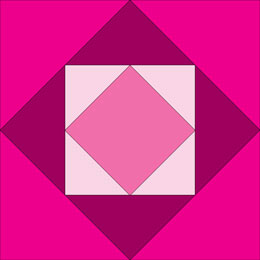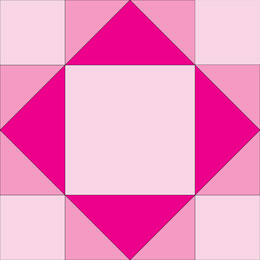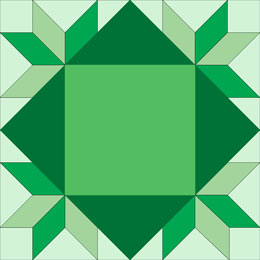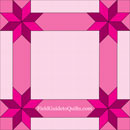| FieldGuidetoQuilts.com |
 Nested Squares
*** Nested Squares
***
|
Click on an icon to go directly to the block you're interested in.
Coming
soon:
| Box: How to change a block's size without a computer |
Twelve Triangles
















Twelve Triangles
 Twelve Triangles
Twelve TrianglesFarm Journal & Farmer's Wife, 1941
It's almost identical to Clara Stone's Scrap block. Scrap, however, has one more square, an off-point square in the center.
It's one of only three blocks on this page with an on-point center square.
Scrap
















Scrap
 Scrap
ScrapStone, 1906From Clara Stone's Practical Needlework (1906). The block is identical to 12 Triangles, except that 12 Triangles lacks the off-point square in the center.
The more colors and curliques there are in a quilt, the simpler a quilt's pattern has to be to make sense to the eye. To look really terrific, Scrap would have to be made fairly large or else it would have to have fairly strong contrast in color values.
In this context, color value amounts to how light or dark the fabric is. Quilters use a handy gadget called a "Ruby Beholder" to compare fabric colors. A ruby beholder works like the red filter on a camera lens. When you look through it, the fabrics show up in shades of gray, and you can tell more easily which fabrics are darker and lighter.
Godey's design
















Godey's design
 Godey's design
Godey's designGodey's considered quilting (that task of the thrifty wife) beneath the dignity of its well-bred readers, who were presumed to prefer decorative needlework. The block at left is one of the few that the magazine ever published.
Godey's ossified along with its "editrix," Ms. Sarah Jessica Hale, who became ever more ladylike until she essentially shriveled up and fell off her editorial chair. She was so ladylike that she ignored all unpleasant topics, including the Civil War. If you were an 1860s homemaker and worried that your son would come home missing a leg, you weren't apt to look to Godey's for social guidance.
Hour Glass & Economy
















Economy
 Hour Glass
Hour GlassLAC, #196, 1897
 Economy
EconomyLAC, #264, 1897
















Hour GlassHour Glass and Economy, below, are both from the Ladies Art Company's 1897 catalog, but while they are sisters, they're not twins.
Hour Glass, the LAC's block #196, has a border with end-to-side corners. That's how Log Cabin blocks are built.

Economy, the LAC's #264, has diagonal seams, meaning mitered corners.

But then, Economy, the LAC's #264 (1897), has no border. The seams run diagonally from corner to center triangles. The name Economy Patch is from 1935 (Hall).
The King's Crown
















The King's Crown
 The King's Crown
The King's CrownKCS, 1931 Thrift Block
It's hard not to like The King's Crown, which is a simple pattern ideal for scraps and print fabrics. The block's first publisher, the Kansas City Star (1931), recommended dark, light, and print fabrics, with the print in the four corner squares.
It would be very simple to make the opposite squares in two colors, creating a four-patch between the large blocks.
The name Thrift Block is from designer Nancy Cabot (1937).
Square & Star
















Economy
 Square & Star
Square & StarLAC, #263
1897Godey's Lady's Book Block/Joseph's Coat/Squares & Triangles
Square & Star, No. 263 of the Ladies Art Company catalog of 1897, is based on an 8x8 grid.
Yet the LAC offered a pattern for the block that, when finished, was 13 inches. Why pick such a nutty size? Each piece would be 62.5 percent larger than it would be if the finished block were 8 inches by 8.
There must be a reason, because the LAC patterns were quite often offered in 13 — and 9 — inches. It's one of quilting's little mysteries.
| Box: Henry Brockstedt, who with his wife founded the Ladies' Art Company in 1889, was a printer by trade. To change the size of a block, he probably changed the size of the grid using a printers' little magical trick. Here's how: If you want a 13" block, you tilt your ruler so that 13" fits from one side to the other, then mark it with dots, then draw a line through the dots. It only seems obvious after you learn it. The illustration shows how to reduce the size of a block. To increase the size, you mark every other inch. |
 |
Quatrefoils
 Quatrefoils
Quatrefoils
 Quatrefoils
QuatrefoilsCabot, 1936
 Nancy Cabot designed this block for her Chicago Tribune column, in which it appeared in 1936.
Nancy Cabot designed this block for her Chicago Tribune column, in which it appeared in 1936. We're not 100% sure why Cabot named the block as she did. A basic quatrefoil is a like a four-petaled flower with a round part at the top. The closest shape we know of in quilting (so far) is in Hearts & Gizzards
Quatrefoils were all over the place in Gothic architecture, and in home decoration today, they're inescapable.
Swallows in the Windows















 Diamonds in the Corners
Diamonds in the Corners
 Swallows in the Windows
Swallows in the WindowsFoland, 1930
We did that for you, gentle reader. Click on the "Make it!" icon for a diagram.
Jackson Star















 Jackson Star
Jackson Star
KCS, 1933
The difference between Jackson Star and its sister, Four Stars Patchwork, is minor. Jackson Star has distinctive color placement, while Four Stars Patchwork (Ladies Art Company, 1897) is in just two colors.
See Four Stars Patchwork here, where it's compared with a block called Old Maid's Patience:
Jackson Star and Old Maid's Patience are drawn on a star grid.
Lotus Star















 Lotus Star
Lotus Star Lotus Star
Lotus StarVirginia Snow/
Grandma Dexter
ca. 1932
 |
| Would you buy a block from this man? His advertising portrait tells us that Mr. Dexter was a powerhouse of corporate rectitude, and he could probably charm your grandma too. |

After Collingbourne Mills of Illinois bought Dexter Yarn of Rhode Island in 1927, several block design booklets were published as collaborations between Collingbourne's "Virginia Snow" and Dexter's "Grandma Dexter." Lotus Star is in both booklet 96A and 96B. The latter was published around 1932.
Lotus star is based on a 10 x 10 grid, according to Beyer's Quilter's Album. We haven't found a pattern on the Web, so we've posted a diagram (click on "Make it!" icon above).
New Album















 New Album
New Album
 New Album
New Album LAC #36
1897
Mrs. Bryan's Choice















 Mrs. Bryan's Choice
Mrs. Bryan's Choice
 Mrs. Bryan's Choice
Mrs. Bryan's Choice Mrs. Bryan's Choice
Mrs. Bryan's Choice Stone, 1906
(colors reversed)When Mrs. Bryan's Choice appeared in 1906, Clara Stone showed it with extra seams (near left) that made almost every patch into a triangle. She was the only designer who did. The block at far left has been the standard ever since.
The block is named for Mary Baird Bryan, wife of the Nebraska congressman William Jennings Bryan. Bryan was a farmer's hero. A Democrat, a populist, and a brilliant speaker, he stood for working people against the wealthy east-coast establishment. In 1906, Bryan had run unsuccessfully for President twice and was poised to try (and lose) once more.
Nowadays, Bryan is best known from the 1950s-era play and movie Inherit the Wind: He argued for the prosecution in the Scopes "Monkey" trial, in which a teacher was tried for breaking Tennessee law by teaching evolution.
Bryan won the case. In the play, he dies on the spot. In rreal life, Bryan died in his sleep, exhausted, five days later. The verdict was eventually overturned.
The Bryans' daughter Ruth Bryan Owen became a congresswoman.








